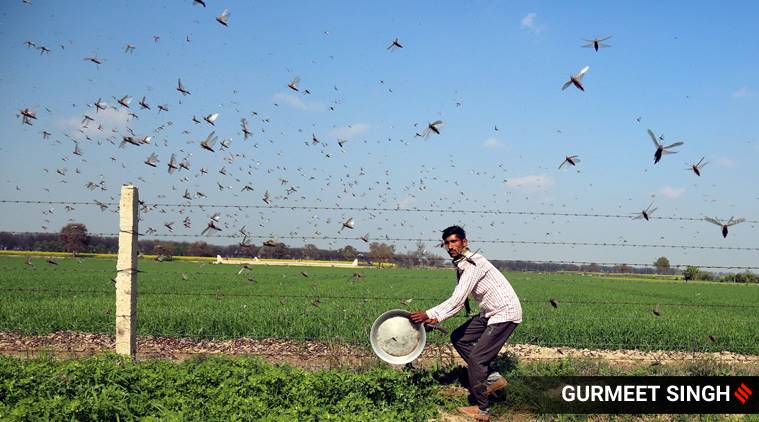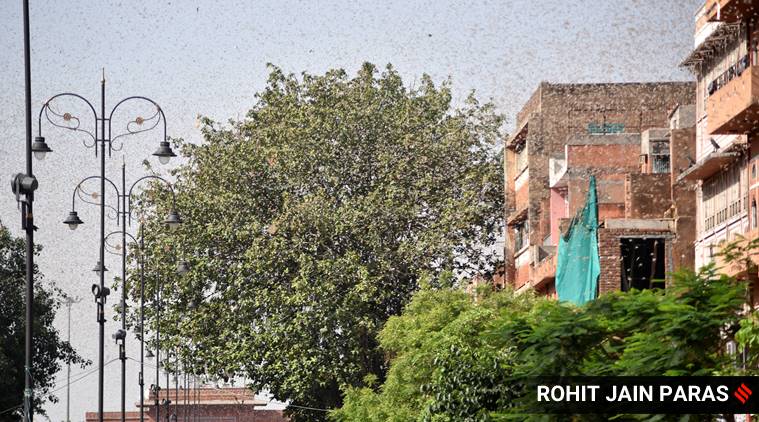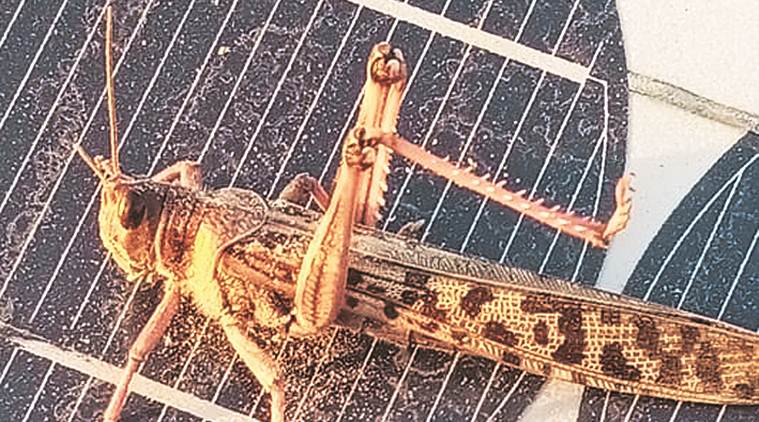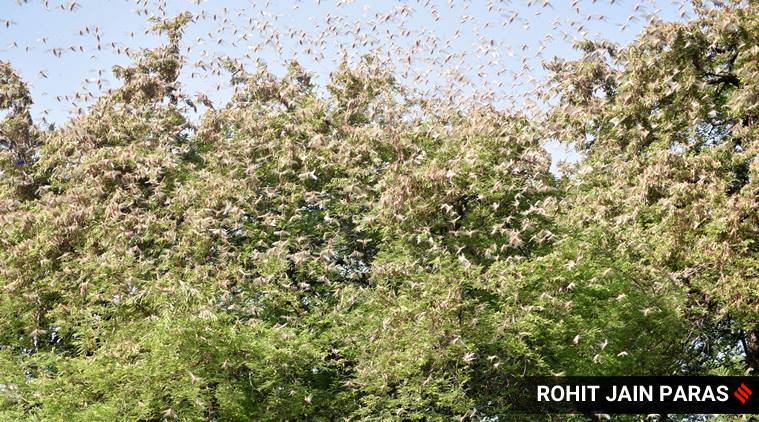
The Indian Express
Govt steps up locust control operations; drones to be deployed soon as Nagpur, UP stay on alert
The government has placed an order for buying 60 spraying machines from UK-based company Micron, and two firms have been finalised for supply of drones for aerial spraying of insecticides for effective control over tall trees and inaccessible areas
by PTIThe government has stepped up efforts to control spread of swarms of locust, a crop damaging migratory pests, in Rajasthan, Gujarat, Punjab and Madhya Pradesh, and plans to soon deploy drones for spraying pesticides, the Union Agriculture Ministry said on Wednesday.
About 21 districts in Rajasthan, 18 districts in Madhya Pradesh, 2 districts in Gujarat and 1 district in Punjab have undertaken locust control measures till now, the ministry said in a statement.
It has been controlled in 47,308 hectare areas so far in Rajasthan, Gujarat, Punjab and Madhya Pradesh, it said. The government has placed an order for buying 60 spraying machines from UK-based company Micron, and two firms have been finalised for supply of drones for aerial spraying of insecticides for effective control over tall trees and inaccessible areas, it added.
“Usually, the locust swarms enter the scheduled desert area of India through Pakistan for summer breeding in the month of June/July with the advent of monsoon.
“This year, however, incursions of locust hoppers and pink swarms have been reported much earlier because of presence of residual population of locust in Pakistan which they couldn’t control last season,” the statement said.
Incursions of locust hoppers have been reported since April 11 and that of pink immature adults since April 30 in bordering districts of Rajasthan and Punjab, which are being controlled, it said.
Pink immature adults fly high and cover long distances during day hours along with the westerly winds coming from the Pakistan side. Most of these pink immature adults settle on trees during night, and mostly fly during the day, it explained.
Stating that control operations are in full swing currently, the Ministry said so far locusts have been controlled in 47,308 hectare area in total 303 places in Rajasthan, Punjab, Gujarat and Madhya Pradesh by Locust Control Officers in coordination with district administration and state agriculture department.
However, there are active swarms of “immature locust” in 8 districts in Rajasthan (Barmer, Jodhpur, Nagaur, Bikaner, Ganganagar, Hanumangarh, Sikar and Jaipur) and 7 districts in Madhya Pradesh (Satna, Gwalior, Seedhi, Rajgarh, Baitul, Devas, Agar Malwa), it said.

“The immature locust is very active and their mobility makes it difficult to control the swarm at one location and it takes 4 to 5 days of control at different locations to control a particular locust swarm,” it said, adding that control operations are being undertaken in morning hours on a daily basis.
At present, 89 fire brigades for pesticide spray, 120 survey vehicles, 47 control vehicles with spray equipment and 810 tractor mounted sprayers have been deployed for effective locust control, as per requirement on different days.
For effective control of locusts beyond scheduled desert areas, temporary control camps have been established in Ajmer, Chittorgarh, Dausa in Rajasthan; Mandsaur, Ujjain, Shivpuri in Madhya Pradesh and Jhansi in Uttar Pradesh, the ministry added.
The ministry said it has received permission from Civil Aviation Ministry for use of drones for locust control. “Two firms have been finalized through tender for use of drones for spray of pesticides for locust control,” it added. Currently, the Locust Control Offices have 21 Micronair and 26 Ulvamast spray machines which are being utilized for locust control.
Meanwhile, supply order for procurement of additional 55 vehicles has been placed to strengthen the control potential. Adequate stock pesticide Malathion has been maintained at Locust Control Organizations. Advisories have been issued to Rajasthan, Gujarat, Haryana and Punjab regarding the locust attack and necessary measures to be taken for effective control and pesticides that are to be used for effective locust control in cropped areas.
Sharing the Food and Agriculture Organization’s (FAO) update on locust swarms issued on May 21, the ministry said the UN body has said that the current situation remains extremely alarming in East Africa where it is an unprecedented threat to food security and livelihoods.

New swarms will migrate to the summer breeding areas along both sides of the Indo-Pakistan border as well as to Sudan and West Africa. As vegetation dries out, more groups and swarms will form and move from these areas to the summer breeding areas along both sides of the Indo-Pakistan border, FAO had said. Good rains are predicted during the first half of June along the Indo-Pakistan border that would allow egg-laying to occur, it added.
During 2019-20, India witnessed a massive locust attack which was successfully controlled. Starting from May 21, 2019 till February 17, 2020, a total of 4,03,488 hectare area was treated and locust swarms were controlled, the statement said.
Swarms of locusts now enter Bhandara district from Nagpur
Swarms of locusts that had entered Katol and Parseoni in Nagpur district of Maharashtra over the last four days, have now moved to the neighbouring Bhandara district, an agriculture department official said.
These crop-eating pests moved to Mohadi tehsil in Bhandara district during the day on Wednesday, before being
spotted in Temani village in Tumsar taluka by late night, Divisional Joint Director of Agriculture Department, Ravi
Bhosle told PTI.
“The swarms of locusts on Wednesday moved to Mohadi in Bhandara district and were spotted in two villages in that
tehsil. By around 10 pm, the locusts were spotted in Temani village in the district,” he said. The swarms stretching up to 17 kms in length had first entered farms in Fetri, Khangaon in Katol in Nagpur district and in Ashti taluka in Wardha district on Saturday night and Sunday where they damaged orange crop and vegetable plantations in some areas, before moving towards Parseoni tehsil on Monday night.

Besides tracking the movement of locusts, officials are now trying to displace the pest from agricultural fields, the official said. “We have started ‘Operation Locust Control’ by spraying pesticides through fire tenders and flood lights,” he said.
Locusts reach Jhansi, other UP districts on alert
After attacking crops in Madhya Pradesh, a swarm of locusts reached Jhansi district on Wednesday, an Uttar Pradesh official said. Other districts in the region are also on alert. Locusts struck the district last week as well, but authorities said they eliminated half of that swarm with the help of local people.
The latest swarm was spotted in neighbouring Madhya Pradesh’s Datia district. Anticipating its arrival, Jhansi administration had already deployed fire brigade vehicles loaded with pesticide. The locusts reached Skill village in Garautha tehsil around 4.30 pm and efforts were on to drive them away, Jhansi division’s Deputy Director Agriculture Kamal Katiyar told PTI.
The swarm is spread over an area of about one square kilometre, he said. Insecticide is being sprayed, he said. Farmers have been advised to play loud music to deter locusts. “A relatively small swarm of locusts was also spotted in Datawali village under Samthar police station area,” Katiyar said. Locusts had earlier attacked some parts of Jhansi district ion May 22 and 24.
As part of preparations for another wave, two fire brigade vehicles with insecticide were deployed in all four Jhansi tehsils.
In addition, six vehicles were kept ready at the district headquarter. Ten municipal employees with two insecticide spraying machines have been posted in every block, Katiyar said. Locusts don’t target animals or humans but can devastate crop fields.
Banda, Mahoba, Hamirpur and Chitrakoot districts in UP are also on alert to the possibility of locusts flying in from Madhya Pradesh, where swarms have been spotted in Chhatarpur and Panna districts as well. The locust threat also figured during a routine meeting chaired by Chief Minister Yogi Adityanath. He said all protective measures must be taken, a spokesman said.
Banda DM Amit Singh Bansal Wednesday said a committee has been formed under the chief development officer and all field officers alerted. Bansal said farmers have been told to inform their village `lekhpal’ as soon as they come to know about locusts arriving in their areas.
He advised beating drums and playing music to prevent a swarm from settling on agriculture fields at night.
Rashtriya Kisan Manch said the government should conduct a physical verification to assess the damage caused in locust attacks.